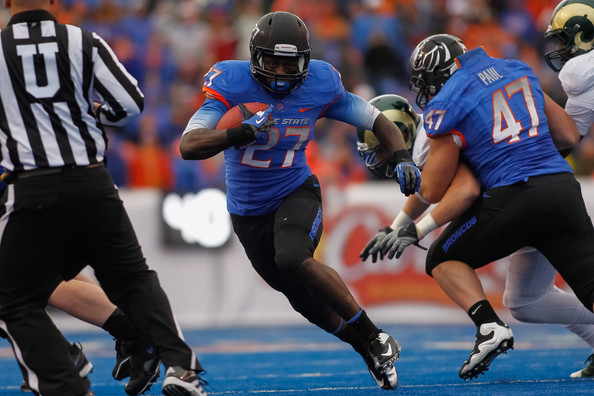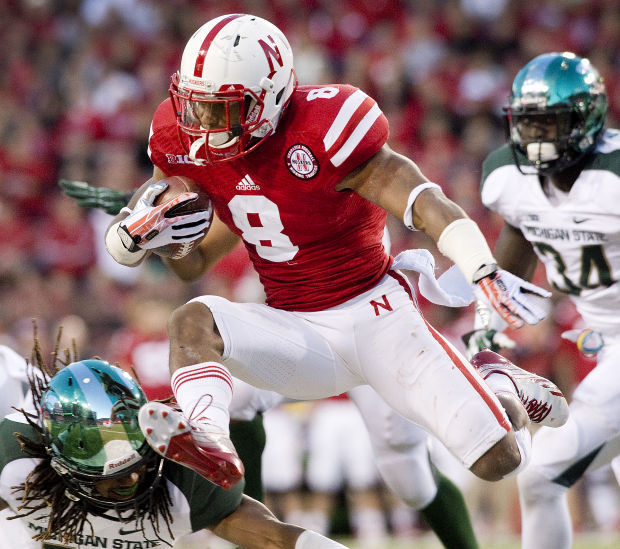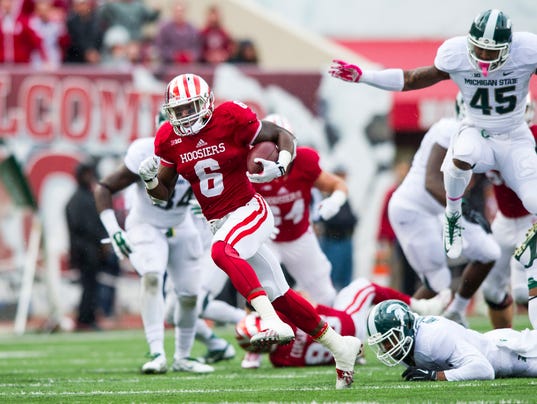Over the next few weeks I will be
looking at the top prospects in the NFL draft, breaking them down position by
position. Today I am starting with the running backs, which in retrospect seems
like a strange place to begin. The running back position has become devalued
over recent years, teams moving away from investing high picks in them thanks
to a short playing career and the relative ease of finding talented players
later in the draft.
There hasn’t been a running back
taken in the first round since Trent Richardson, Doug Martin, and David Wilson
went in 2012. This year, however, we are likely to see that change. There are a
couple of top talents who could come off the board on the first day, and
several more who could provide great value in the second or third rounds.
Thanks to DraftBreakdown.com, I was able to watch at least three games from
seven of the top running backs. Here they are, ranked from top to bottom based
on what I saw on the tape.
Todd Gurley – Georgia
There is no question that Gurley
is the most talented running back in the draft. He is probably the most
talented running back to enter the league in the past three years, boasting a
rare combination of size, speed, and agility. At his heart he is a power back,
slamming between the tackles and fighting for every available yard. Tacklers
seem to slide right off of him, and he is almost impossible to bring down
unless you hit him square.
He also happens to be one of the
shiftier running backs available at the top of the draft. He is more run you
over than make you miss, but he is capable of doing either and usually makes
the smart choice as a runner. He has exceptional balance, and it is common to
see him stumble forward for five extra yards even after it looks like the
defense has him stopped.
There are no questions about
Gurley’s talent. He has all the breakaway speed you could want, solid skills as
a receiver and a blocker, and consistently demonstrates smart cutbacks when the
hole isn’t available (he is no Trent Richardson is what I’m saying.) The only
thing he really lacks is the ability to get around the corner that some of the
backs below use to great advantage. When there is absolutely nothing available
in the middle, he usually just slams the ball ahead for a gain of two or three
yards. He doesn’t have the ability to break it outside, and he can’t
consistently turn a nothing play into a great play. But he understands this,
and he rarely gets caught dancing in the backfield. Negative plays are hard to
find, and even though he lacks the boom of some of the other runners, he makes
up for it by also lacking the bust.
The real issues with Gurley are
durability. He is coming off of a torn ACL, and it is difficult to project how
he will recover. Will he be like Adrian Peterson and bounce back as good or
better than ever? Or will he be like Marcus Lattimore, subject to recurring
injuries until his talent evaporates?
Even with these concerns, I can’t
look past the pure talent. Had Gurley entered the league completely healthy ten
years ago, he probably would have been the first player picked. Running back
has been devalued, and the injuries increase the risk, but whoever gets Gurley has
a very good chance of ending up with one of the best running backs in the NFL.
Melvin Gordon – Wisconsin
Melvin Gordon isn’t who people
think he is. The common perception seems to be that he is a quick, shifty back
who specializes in space, the sort of runner who is a nightmare in the open
field but not necessarily a force between the tackles. And while Gordon is at
his best on the edge, he is also a very dangerous runner when attacking the
center of the field.
Gordon’s greatest asset is his
straightline speed. When he gets past the edge of the defense, he demolishes
pursuit angles and can outrace the opposing team to the endzone. Above I
mentioned Gurley’s lack of speed around the corner, and this is the one area
where Gordon absolutely dominates him.
This speed also translates to his
interior rushing attack. If a hole opens for even a split second, he can be through
and to the second level before the defenders have a chance to react. He doesn’t
have anything near the raw physical power of Gurley, but he is better at
gaining yards after contact than people give him credit for. He can break the
occasional tackle, and he almost always manages to avoid a direct hit, giving
him the ability to finish forward.
There are a few areas in which
Gordon falls short of expectations. He doesn’t really have the lateral
quickness to make people miss in the open field, and if a defender can get him
sized up he can usually bring him down. His short strides and choppy feet let
him make subtle cuts to get past flatfooted defenders, but he doesn’t have the
sharp stop-start ability of someone like LeSean McCoy. He also offers next to nothing
as a receiver or a blocker, and aduring the early part of his career he will
have to come off the field in third down situations.
There is one more concern
regarding Gordon, one I don’t put much stock in but at least needs mentioned.
The offensive line he played behind at Wisconsin
was one of the best in college football, and he could always count on wide open
lanes to run through. The one time his line faced a defensive front that could
match them, Ohio State held Gordon to 76 yards on 26
carries. He likely won’t see the same consistent dominance in front of him in
the NFL, and there have to be a few concerns about how his success will carry
over, especially after what we saw from Trent Richardson. Gordon has the talent
and the vision to overcome this, but it does have to be considered as a risk.
Gordon is a more complete runner
than people give him credit for, but he still doesn’t measure up to Gurley. The
injury concerns bring them closer, but in my mind I still see a wide gap
between the two. Gordon will be a solid running back in the NFL, but at this
point I’m not sure if I would spend a first round pick on him.
Duke Johnson – Miami

Johnson is a smaller, quicker
back who excels in open space. At only 5’9”, he still manages to pack 207
pounds onto his dense frame, giving him serviceable strength to go along with
his quickness. There is nothing special about him physically, at least not
compared to the other top running backs. He doesn’t have the size or speed of
either Gurley or Gordon, but his skills as a runner put him at the top of the
next tier of running backs.
Johnson is probably the most
polished runner available in the draft. He has excellent vision and patience to
let holes develop, and he has the stop-start ability to make the cuts needed to
exploit the holes he finds. He doesn’t dance around defenders, but he makes
smart cuts to break down their angles and knock them off balance. Most
importantly, he always attacks downhill. Johnson isn’t the sort who will be
caught in the backfield, and he will happily accept a good play rather than
trying to create a great play.
What really sets him apart from
all other running backs in the draft is his skill as a receiver. He is an
excellent route runner out of the backfield on swings, wheels, and especially
angle routes that start him moving to the outside before bringing him back over
the middle. His eyes will occasionally get ahead of his hands, causing drops as
he attempts to transition from a receiver to a runner, but his overall ability
makes up for these occasional lapses. A smart coach will take full advantage of
this ability, even lining him up as a slot receiver where he saw some work in
college.
As polished as he is, Johnson
just doesn’t match up physically with the other top backs. He isn’t strong
enough to consistently run through tacklers, and his straightline speed is
merely average. In addition, there are serious ball security issues that need
addressed before he can be a reliable option. All of this puts him well below
Gurley and Gordon at the top of the draft.
Nonetheless, the skill is there.
Johnson will be a very valuable addition in the second round, particularly for
a team looking for immediate contribution. If a solid team with a strong core (Dallas is the first that
jumps to mind) was to grab him, he could find enough immediate success to be a
Rookie of the Year contender. However, teams willing to be patient and develop
a longer term option may prefer to go with the next back instead.
Jay Ajayi – Boise State

In terms of pure ability Ajayi is
right up there with the top two runners in the draft. He has impressive size at
221 pounds, and he plays that big on the field, shedding tacklers and fighting
for yards nearly as well as Gurley. He has good speed for a back his size,
running a 4.57 40 yard dash. He doesn’t play quite that fast on the field, but
he shows more than enough speed to break big plays.
Ajayi has everything needed to be
a great running back, except that he isn’t really that great of a running back.
He is too eager to bounce plays to the outside, seeming to believe he is faster
and smaller than he actually is. He plays too eager at times, running up his
blockers’ backsides before the holes can develop. Put together these lead to a
lot of negative plays of the sort you just don’t see from the running backs
above him.
As raw as he is, it is difficult
not to be awed by Ajayi when he sticks his foot in the ground and actually
attacks downhill. He has fantastic lateral quickness, and he can make people
miss in the open field as easily as he can run them over. He doesn’t lose speed
when making cuts, and he shows good vision once he gets past the line into the
open field. In the passing game he offers more as a receiver than as a blocker,
but on the whole he is the sort of player you can feel good about leaving on
the field for all three downs.
Good coaching can cure Ajayi of
many of his flaws, and since every coach believes he is a good coach I think
it’s likely that Ajayi will be the third running back off the board. And while
he could very well live up to these expectations, the risk he carries is higher
than any other back in the draft. He is an interesting project who could one
day turn out to be the best running back from this year’s class, but I would
hesitate to take him before the latter half of the second round.
Ameer Abdullah – Nebraska

There are three clear tiers among
the running backs on this list. Gordon and Gurley are clearly head and
shoulders above the rest, and there is a similar drop from Johnson and Ajayi to
the next group of running backs. These three at the bottom are grouped fairly
tightly, and it wouldn’t be a mistake to choose any of them over the others.
But of the three, I rank Abdullah as the highest because he is the most
complete as a runner.
Stylistically, Abdullah is a very
similar player to Duke Johnson. What he lacks in speed and size, he makes up
for in skill and experience. He is a smart runner who knows how to find and hit
holes, and he never tries too hard to make more out of a play than is
available. He is a skilled receiver who can run routes out of the backfield or
from the slot, and he will be able to contribute in a variety of ways on
special teams. All around, he is a useful player to have on your team.
But it is difficult to look at
him and see much upside. His straightline speed is merely average for a player
of his size. He doesn’t run well up the middle and is easily brought down by
arm tackles. In college he was just quick enough to beat lesser athletes to the
hole, but against the top tier players in the NFL he will struggle to find
success on anything other than outside runs.
The one place where Abdullah
truly excels is in space. He is very quick, and he understands how to work side
to side while still attacking upfield. To start in the NFL he can be a very
useful kick returner, and a team can find a role for him as a third down back.
Long term there is a slight chance he can take on a more substantial role, but
he is limited enough that I probably wouldn’t invest anything higher than a
third or fourth round pick in him.
David Cobb – Minnesota
If you want a big, powerful back
who can run through tackles, Cobb is your guy. If you want someone who’s going
to run away from defenders, he’s not. At 229 pounds and running a 4.81 40, Cobb
is a strictly between the tackles runner. There’s nothing flashy about his
game, but he can pick up a reliable three or four yards at a time if a hole is
available.
Cobb has reasonably quick feet,
and he is better at changing directions than you’d expect from a back of his
size. But his vision is subpar, and if a hole isn’t made immediately available
he can get swallowed up in the line. He doesn’t bring much acceleration, and he
isn’t the sort who can generate leg drive from a dead stop.
But once he’s built up a head of
steam, it is a completely different story. Cobb can easily turn a five yard
gain into a ten yard gain through pure momentum, and if he has a lane to build
his speed through he can outpace linebackers down the field. He’ll never break
off fifty or sixty yard runs, but with good blocking he can churn out carries
of ten or twenty yards.
Cobb can take a pounding many of
these other backs can’t, and a team in need of someone to carry the ball
fifteen times a game might be better off investing a third round pick in him
than the others in this tier. But he’ll never be more than a useful piece of a
larger backfield, and his limited upside puts him below the backs who have the
potential of being more complete players.
Tevin Coleman – Indiana

Coleman is pretty much the
opposite of Cobb. Another high profile Big Ten running back, his game is
defined exclusively by his speed. There’s a very real chance he has never
broken a tackle in his life. In fact, a strong breeze might be enough to knock
him over. He’s listed at 206 pounds but plays so much smaller.
Between the two one dimensional
running backs, I put Coleman below Cobb because he is the less polished player.
He struggles to read his blocks and find holes, and he shows almost no lateral
agility. Straightline speed is the only tool in his kit, and as long as you can
stay in front of him he isn’t going to do much against you. Many of his runs
end up stuffed right at the line of scrimmage, and he shows no ability to make
something positive when nothing presents itself.
But when Coleman gets into the
second level of the defense, he is a sight to behold. His speed makes it look
like he’s playing a different game than the rest of the defense, and if he can
get past the first level there’s really nothing to stop him before he hits the
goalline. He is the sort of player who will break a four or five sixty yard
touchdown runs over the course of the season, just enough that a coach will
stick with him through countless plays stuffed at the line. In the right system
he could be a useful change of pace, but I would never consider spending more
than a fourth round pick on him.
No comments:
Post a Comment